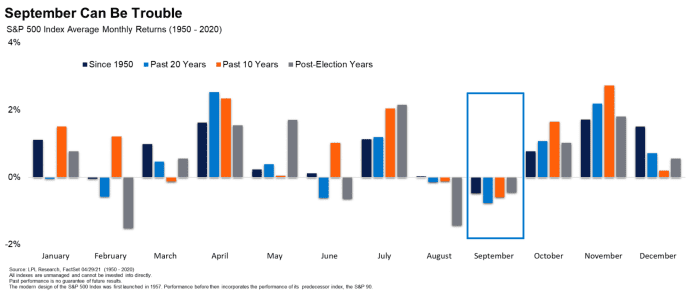This post was originally published on this site
Even as stocks look set to reach new highs in September, the feeling of dread on Wall Street is palpable.
Strategists (and the media) have been incessantly droning on about the seasonal trends that place September as one of the worst months of the year for equity benchmarks.

via LPL Financial
Even last year, when stocks were in a nearly ceaseless race to records, the S&P 500
SPX,
took a September nosedive that saw it wipe out nearly 10% in value at one point before resuming its bullish rally.
Ultimately, September 2020 registered a 3.9% decline for the S&P 500, coming after five straight months of sharp gains in the aftermath of the COVID-19 pandemic that brought financial markets, and the general public, to a near standstill.
This time around, investors are worried because the markets are on a similar tear, with seven straight months — and counting — of gains for the broad-market benchmark, and there is a growing sense that valuations are rich and the Federal Reserve’s easy-money punchbowl will soon be yanked away.
Seven months of consecutive gains is an impressive tally:

via LPL Financial
Ryan Detrick, in a research note on Tuesday, intoned the usual warning for this time of the year.
“Although this bull market has laughed at nearly all the worry signs in 2021, let’s not forget that September is historically the worst month of the year for stocks,” wrote the LPL Financial chief market strategist.
There is little doubt about the narrative surrounding the reason for uneasiness:
- The jobs report Friday
- Valuations are rich for stocks, depending on your measure
- The delta variant of coronavirus is spreading as schools open
- Inflation worries
- The Fed meeting Sept. 21-22
- The debt ceiling
- Quadruple witching options and stock expirations
- Gravity
Sahak Manuelian, head of equity trading at Wedbush Securities in Los Angeles, told MarketWatch’s Joy Wiltermuth in an interview that volatility could very much be a factor this month.
“I think that September, and the volatility that’s usually around in September, can really come back into play,” the trader said.
That said, MarketWatch columnist Mark Hulbert made the case that despite statistics that show September (and October, which is arguably worse) is a terrible month for equities, investors shouldn’t be swayed simply by loose correlations.
“Stock market lore is filled with correlations that are statistically significant but have no real-world significance,” Hulbert wrote.
Paul Schatz, the president of Heritage Capital, offered some similar advice in a blog post, noting that the negative data on September also depends on how you look at the statistics around the month’s performance.
“As the calendar turns, plenty of pundits have been discussing that September is historically the worst month of the year for stocks. That’s is factually correct. Depending on which year you cherry-pick the starting date,” Schatz writes.
“September averages a negative return of -1.10% since 1928. However, the devil is really in the details,” he said.
He makes the argument that the performance of August, which was strong this year (and it was strong last year too), plays a factor in September figures.
“If we look at times where the stock market begins September in an uptrend, the negative return becomes positive by roughly .5%,” he wrote. “In turn, that also tells us that when the stock market begins the month already in decline, it averages almost -3%.”
Any way investors slice it, the market is likely to be bound for choppiness, considering that nothing goes up in a straight line forever and that the S&P 500 has yet to post a drawdown (a pullback from its recent peak) of 5% or worse this year.
Detrick said that the market’s persistent monthly gains thus far may offer a better gauge of the market’s performance in the coming three-month, six-month and 12-month periods, with average gains of 4.1%, nearly 8% and 9.5%, respectively, in those periods in which the S&P 500 has produced win streaks of at least seven months.

via LPL Financial
On Wednesday, markets got off to a fairly solid start for September. The Nasdaq Composite
COMP,
notched its 33rd record of 2021, and the S&P 500 narrowly missed its 54th all-time closing high, with gains petering out. The small-capitalization Russell 2000 index
RUT,
rose by about 0.6%.
However, the Dow Jones Industrial Average
DJIA,
posted a 0.1% loss to start the month.
Wall Street will soon see how September shapes up.



